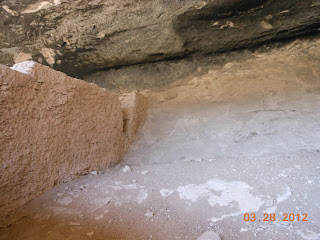The Gila Cliff Dwellings National Monument was established on November 16, 1907, by President Theodore Roosevelt for its scientific and educational interest. This area was the best representation of the Mogollon Cliff Dwellers. We were awed by the historical value of the cliff dwellings. The thought of walking in these caves that were inhabited by the cliff dwellers over 800 years ago was chilling.
The people who built the cliff dwellings were part of the Mogollon culture. They built many homes in the mountainous areas of Arizona and New Mexico. Since the Mogollon may have found abundant game and fertile soil in the Gila River valley, it is believed they build these caves with rock, mortar and timbers between 1276 and 1287. By 1300 the cliff dwellers had moved on. Over 100 years after they left, the Apaches migrated to the Gila River. Geronimo was born near the Gila River and some Apaches claim it as their homeland. By 1870 the federal government began relocating the Apaches onto reservations but it wasn't until September 1886 that the last of Geronimo's people were forced from their ancestral lands.
The story of the cliff dwellings begins long before people arrived. Two large volcanoes erupted in this area and produced more pumice and ash than 1,000 Mt. St. Helens. The layering of ash and other sediment produced soft and hard rock. Rivers and creeks could undercut the rock too form alcoves and eventually large caves.
There are seven caves in this village. Some of the caves were more developed than others. One was very large. The caves provided protection from the sun in the summer and held the warmth of the winter fires. There are various theories of possible uses for each room - gathering for ceremonies, sleeping, cooking - just to name a few.
Because of the natural protection of the caves, these dwellings are the best preserved ancient structures in the area. The interior of the caves still have fire rings, grain bins and benches that were created by its inhabitants. The circular depressions may have supported large, round bottomed pots called ollas.
The ranger gave us an informative tour with an added sense of humor. Pete and Suzy are working their way to the caves along the mountain path. Bill and Teri are pleased someone offered to take a picture in this amazing place.
Some spring flowers blooming along the path and an interesting view from inside the cave overlooking the valley and nearby cliffs.































No comments:
Post a Comment